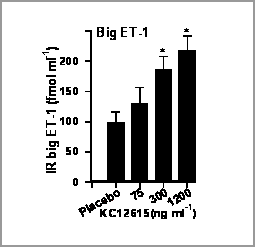Print version
Search Pub Med
The ECE / NEP inhibitor SLV306 (daglutril), inhibits systemic endogenous conversion of infused big endothelin-1 in human volunteers The aim of this study was to determine whether SLV 306 (Daglutril) (Tabrizchi, 2003), a combined inhibitor of the endothelin converting enzyme (ECE) and neutral endopeptidase (NEP), inhibited the systemic conversion of big ET-1 to the mature peptide and the C-terminal fragment (CTF). On four separate occasions, following the oral administration of one of three increasing doses of SLV 306 (to reach an average target concentration of 75, 300, 1200 ng ml -1 of the active metabolite KC 12615) or a placebo, in a randomised, double blinded regime, big ET-1 was infused into 13 healthy male volunteers (mean age 23 years). Big ET-1 was administered at a rate of 8 and 12 pmol kg-1 min-1 (20min each). Plasma samples were collected pre, during and post big ET-1 infusion. Following selective solid-phase extraction, immunoreactive (IR) mature ET, big ET-1 and CTF was measured by RIA (Plumpton et al. 1995, 1996). SLV306 and its major active metabolite showed no cross reactivity in any assay. The infusion of big ET-1 resulted in an increase in a systemic IR big ET-1 by two orders of magnitude above basal levels in the placebo group. SLV306 dose dependently caused a significant rise in circulating big ET-1 levels (compared with placebo, two way analysis of variance, ANOVA, with adjustment for multiple comparisons, p<0.005) indicating that at the two highest doses, SLV 306 was inhibiting an increasing proportion of endogenous conversion activity (Figure 1). In the placebo group, levels of the CTF increased an order of magnitude above basal confirming a proportion of the infused big ET-1 was being selectively converted as expected. In the presence of the highest two doses of SLV 306, a small increase in the CTF was observed, consistent with our previous studies with the dual NEP/ECE inhibitor, phosphoramidon (Plumpton et al. 1995) since CTF is also a substrate for metabolism by NEP and inhibition of this enzyme by SLV 306 may reduce proteolysis. NEP is also thought to metabolise ET-1 to biologically inactive fragments. Intriguingly, despite inhibition of NEP activity, there was no increase in levels of mature ET.
Figure 1. Dose-dependent increase in plasma big ET-1 leavels following SLV306 infusion in human volunteers. (mean±s.e.mean, n=13*ANOVA,p<0.005) These results suggest that in the presence of SLV 306, the biologically active peptide may continue to be removed beneficially from the circulation by clearing receptors. Overall, the results clearly show that SLV 306 can inhibit the conversion of big ET-1 and may be of benefit in cardiovascular disease where big ET-1 levels are elevated, particularly in human atherosclerosis where enzymatic conversion of big ET-1 is significantly upregulated (Maguire & Davenport 1998).
Plumpton, C. et al. (1995) Br. J. Pharmacol. 116, 1821-1828. |


